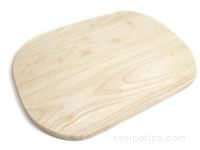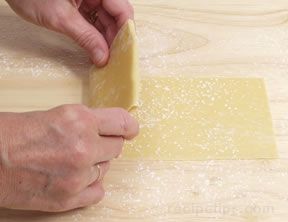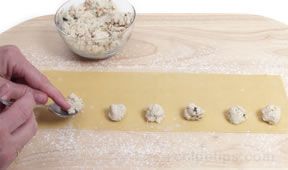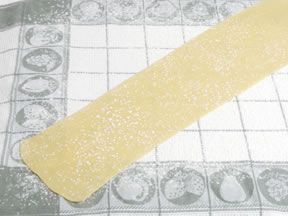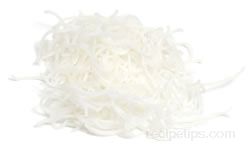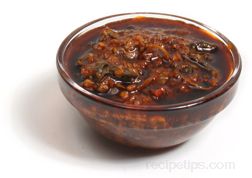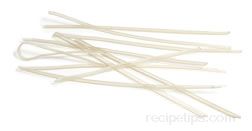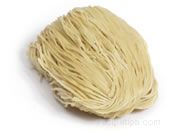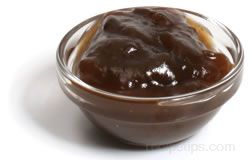|
Asian noodles, like pasta noodles, are available in round, flat and square shapes, and in various widths and lengths. Most often Asian noodles are purchased, rather than made by hand. They are available fresh, dried or partially dried from Asian markets and some varieties are available in food stores.
Asian egg noodles and udon noodles can be made by hand with no more difficulty than making pasta noodles by hand, but udon noodles require a different cooking method. Other Asian noodles require ingredients not as readily available and involve process that make them more difficult to make. Pulled noodles are especially difficult to make by hand, because it requires the ability to twirl stretched out pasta dough in both hands, fold and refold, and repeatedly stretch and twirl, and fold and refold until long fine noodles are formed from the dough. Today most pulled noodles are made by machine.
|
Preparing Asian Noodles:
Various Asian noodles require some preparation before they are used in their final cooking stage. Shown below are some of the preparation processes used for different Asian noodles.
Egg Noodles: Egg noodles do not require any preparation before cooking. Whether fresh or dried, they are ready to cook. If you are using them in soups or stir-fries, they need to be boiled first.
Rice Noodles: Rice noodles need to be soaked before cooking. The flat, regular size rice noodles should be soaked for 10 to 15 minutes in hot (not boiling) water and then drained and rinsed to remove the starches.
|
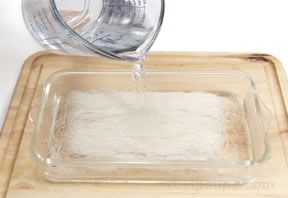 |
- Place the noodles in a heatproof dish and pour hot (not boiling) water over them.
|
 |
- Allow noodles to soak for 10 to 15 minutes.
|
 |
- Pour noodles and water into a colander and allow the water to drain off.
|
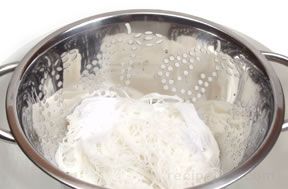
|
- Rinsed the noodles to remove the starches and allow them to drain again.
|
|
Thinner rice noodles, such as rice vermicelli may only need to be soaked for 10 minutes or less to soften. Fresh rice noodles should be softened before cooking by pouring hot water over them while the are in a colander or strainer, allowing them to drain immediately. The fresh noodles generally do not need to soak.
Cellophane Noodles: Cellophane noodles should be soaked in hot (not boiling) water for approximately 5 minutes. Soak only until softened. Rinse and drain well. If the cellophane noodles are going to be deep-fried, they do not need to be presoaked.
|
- Cut the noodles into shorter lengths before soaking. Using a kitchen shears, cut into lengths of approximately 3 to 4 inches.
|
|

|
- Pour hot (not boiling) water over the noodles and allow them to soak for approximately 5 minutes. Loosen and separate noodles as they start to soften.
|
|
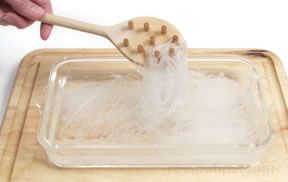
|
- Drain the noodles and then rinse to remove the starches. Allow them to drain again after rinsing.
|
|
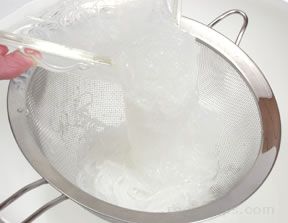 |
| Note: Cellophane noodles are extremely hard before they are soaked. Do not try to break them up with your hands. The noodles have a tendency to break into sharp fragments that can injure your hands. Use a kitchen shears or chop the noodles with a cleaver to break them into pieces. |
| Udon Noodles: Udon noodles do not require presoaking but if they are going to be stir-fried or used in a soup, they should be precooked. For cooking instructions, see Cooking Guide - Asian Noodles. |
|












